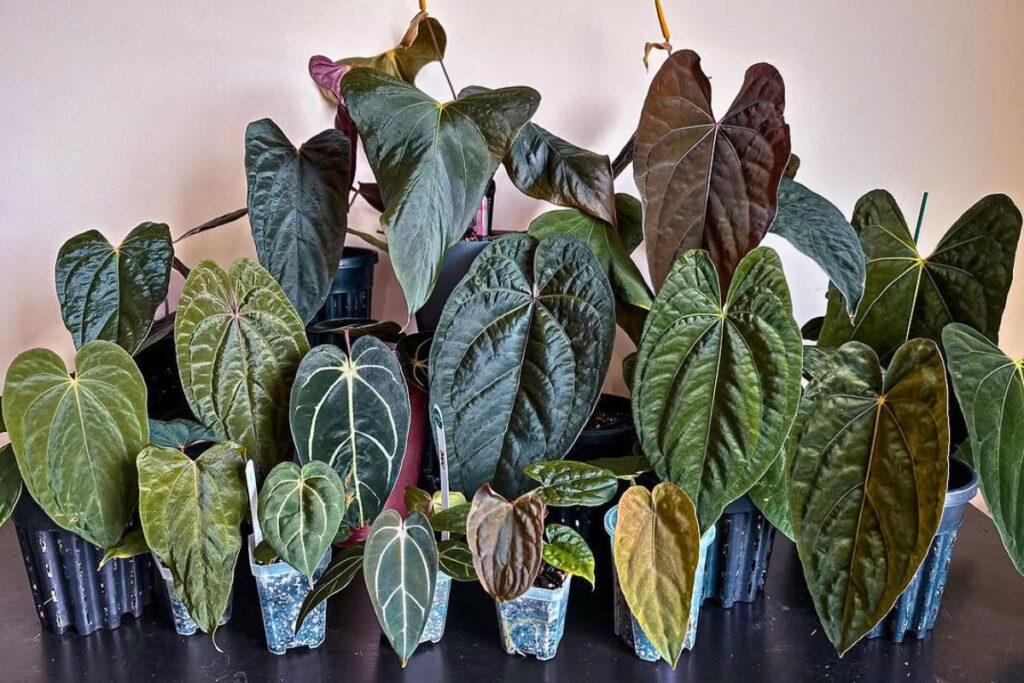Anthurium plants, also known as flamingo flowers or laceleaf, are a popular choice for indoor gardening due to their vibrant, heart-shaped flowers and glossy foliage. These tropical beauties can add a touch of elegance to any space and are relatively easy to care for with the right knowledge. In this guide, we’ll explore everything you need to know to successfully grow and care for anthurium plants indoors.

Contents
Choosing the Right Location
Anthurium plants thrive in bright, indirect light. Direct sunlight can scorch their delicate leaves and flowers, so it’s best to place your plant near a window with filtered light or in a well-lit room. If natural light is limited, you can use a grow light to provide the necessary illumination. Aim for about 6-8 hours of bright, indirect light daily to ensure healthy growth.
Maintaining Proper Temperature and Humidity
Anthurium plants prefer warm and humid environments, similar to their native tropical habitat. Keep your plant in a room with temperatures ranging from 65-80°F (18-27°C). Avoid placing it near drafty windows or heating vents, as sudden temperature fluctuations can stress the plant. To maintain humidity, mist the leaves regularly or place a humidity tray with water and pebbles underneath the pot. A room humidifier can also help create a more suitable environment.
Watering Wisely
Proper watering is crucial for the health of your anthurium plant. Water the plant thoroughly when the top inch of soil feels dry to the touch. Ensure the pot has drainage holes to prevent water from accumulating at the bottom, which can lead to root rot. During the growing season (spring and summer), you may need to water more frequently, while in the dormant period (fall and winter), reduce the frequency to avoid overwatering.
Soil and Fertilizing
Anthurium plants thrive in well-draining, nutrient-rich soil. A mix of potting soil, peat moss, and perlite or orchid bark works well to provide the right balance of moisture retention and aeration. Feed your plant with a balanced, water-soluble fertilizer diluted to half strength every 4-6 weeks during the growing season. Reduce or stop fertilizing during the dormant period to prevent nutrient buildup.
Pruning and Maintenance
Regular pruning helps maintain the shape and health of your anthurium plant. Remove any yellowing or dead leaves to encourage new growth and keep the plant looking its best. You can also trim back any leggy stems to promote a bushier appearance. If your plant becomes too tall or unruly, don’t be afraid to cut it back to a more manageable size. Anthurium plants can tolerate heavy pruning and will often respond with vigorous new growth.
Styling Your Anthurium Plant
Anthurium plants are versatile and can be styled in various ways to enhance your indoor decor. Here are some ideas to help you create a stunning display:
- Elegant Centerpiece: Use a decorative pot and place your anthurium plant on a dining table or coffee table as an elegant centerpiece. Its vibrant flowers will add a pop of color to any room.
- Tall Floor Plant: Allow the plant to grow tall and use it as a striking floor plant to add vertical interest to your space.
- Grouping with Other Plants: Combine your anthurium with other indoor plants to create a lush, green oasis. The contrasting textures and colors can add visual interest to your plant collection.
- Creative Containers: Choose pots and containers that complement your interior design. The contrast between the plant’s vibrant flowers and stylish pots can enhance the overall aesthetic.
Propagation Techniques
Propagating anthurium plants is relatively easy and a great way to expand your collection or share with friends. Here are two common methods:
Stem Cuttings
- Choose a healthy stem with several leaves.
- Using clean scissors or pruning shears, cut a 4-6 inch section just below a node.
- Place the cutting in water or a well-draining potting mix. If using water, change it regularly to prevent stagnation.
- Once roots develop, transplant the cutting into soil.
Division
- Remove the plant from its pot and gently separate the root ball into smaller sections, ensuring each section has at least one healthy stem and root system.
- Plant each section in fresh, well-draining soil and water thoroughly.
Dealing with Pests and Diseases
Anthurium plants can occasionally fall victim to pests such as spider mites, aphids, and mealybugs. Regularly inspect your plant for signs of pests and treat any infestations promptly with insecticidal soap or neem oil. Maintaining proper care practices and a clean environment can help prevent most common issues. Yellowing leaves can indicate overwatering or inadequate light, so adjust your care routine as needed.
Troubleshooting Common Issues
- Yellowing Leaves: Often a sign of overwatering or poor drainage. Check the soil moisture and ensure the pot has adequate drainage.
- Brown Leaf Tips: This can indicate low humidity or underwatering. Increase humidity levels and adjust your watering schedule.
- Leggy Growth: Lack of light can cause leggy growth. Move the plant to a brighter location or provide supplemental light.
Growing anthurium plants indoors can be a rewarding experience, adding a touch of elegance and vibrancy to your home. By following these care tips and paying attention to your plant’s needs, you’ll be well on your way to enjoying a lush and healthy anthurium plant. Happy planting!
